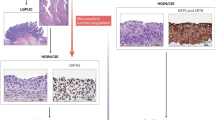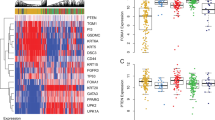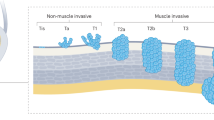Abstract
There is substantial evidence for the existence of mutually exclusive molecular pathways to tumorigenesis, in the formation of papillary and invasive carcinomas, respectively. The most common genetic alterations in low grade papillary transitional-cell carcinoma (TCC) are loss of heterozygosity of part or all of chromosome 9 and activating mutations of the fibroblast growth factor receptor 3 (FGFR3). The pathway to development of invasive TCC seems to start with dysplasia, progress to carcinoma in situ, followed by invasion of the lamina propria. The most frequent genetic alteration in dysplasia and carcinoma in situ is mutation of TP53, followed by loss of heterozygosity of chromosome 9. A marker for progression in TCC is loss of chromosome 8p, which occurs in approximately 60% of bladder tumors. Global trends of increased genomic instability and aberrant methylation of cytosine residues in DNA correlate with increased tumor invasion and progression. When researching markers of bladder cancer for clinical use, it is important that biomedical pathways and their alterations are measured in the same tumor populations. This review examines the published data and proposes a model for the mechanisms behind bladder cancer development.
This is a preview of subscription content, access via your institution
Access options
Subscribe to this journal
Receive 12 print issues and online access
$209.00 per year
only $17.42 per issue
Buy this article
- Purchase on Springer Link
- Instant access to full article PDF
Prices may be subject to local taxes which are calculated during checkout


Similar content being viewed by others
References
National Cancer Institute. NCI Fact Book. Bethesda, Md: National Institutes of Health; 2003.
Brandau S and Bohle A (2001) Bladder cancer. I: Molecular and genetic basis of carcinogenesis. Eur Urol 39: 491–497
Feng Z et al. (2002) 4-aminobiphenyl is a major etiological agent of human bladder cancer: evidence from its DNA binding spectrum in human p53 gene. Carcinogenesis 23: 1721–1727
Knowles MA (2001) What we could do now: molecular pathology of bladder cancer. Mol Pathol 54: 215–221
Williams SG and Stein JP (2004) Molecular pathways in bladder cancer. Urol Res 32: 373–385
Tsutsumi M et al. (1998) Early acquisition of homozygous deletions of p16/p19 during squamous cell carcinogenesis and genetic mosaicism in bladder cancer. Oncogene 17: 3021–3027
Rieger-Christ KM et al. (2003) Identification of fibroblast growth factor receptor 3 mutations in urine sediment DNA samples complements cytology in bladder tumor detection. Cancer 98: 737–744
Dulaimi E et al. (2004) Detection of bladder cancer in urine by a tumor suppressor gene hypermethylation panel. Clin Cancer Res 10: 1887–1893
Friedrich MG et al. (2004) Detection of methylated apoptosis-associated genes in urine sediments of bladder cancer patients. Clin Cancer Res 10: 7457–7465
Markl ID and Jones PA (1998) Presence and location of TP53 mutation determines pattern of CDKN2A/ARF pathway inactivation in bladder cancer. Cancer Res 58: 5348–5353
Sarkar S et al. (2000) Different combinations of genetic/epigenetic alterations inactivate the p53 and pRb pathways in invasive human bladder cancers. Cancer Res 60: 3862–3871
Dunn KL et al. (2005) The Ras-MAPK signal transduction pathway, cancer and chromatin remodeling. Biochem Cell Biol 83: 1–14
Hipfner DR and Cohen SM (2004) Connecting proliferation and apoptosis in development and disease. Nat Rev Mol Cell Biol 5: 805–815
Billerey C et al. (2001) Frequent FGFR3 mutations in papillary non-invasive bladder (pTa) tumors. Am J Pathol 158: 1955–1959
Nicholson RI et al. (2001) EGFR and cancer prognosis. Eur J Cancer 37 (Suppl 4): S9–S15
Oxford G and Theodorescu D (2003) The role of Ras superfamily proteins in bladder cancer progression. J Urol 170: 1987–1993
Cappellen D et al. (1999) Frequent activating mutations of FGFR3 in human bladder and cervix carcinomas. Nat Genet 23: 18–20
Munro NP and Knowles MA (2003) Fibroblast growth factors and their receptors in transitional cell carcinoma. J Urol 169: 675–682
Jebar AH et al. (2005) FGFR3 and Ras gene mutations are mutually exclusive genetic events in urothelial cell carcinoma. Oncogene 24: 5218–5225
van Rhijn BW et al. (2002) Frequent FGFR3 mutations in urothelial papilloma. J Pathol 198: 245–251
Wallerand H et al. (2005) Mutations in TP53, but not FGFR3, in urothelial cell carcinoma of the bladder are influenced by smoking: contribution of exogenous versus endogenous carcinogens. Carcinogenesis 26: 177–184
Bakkar AA et al. (2003) FGFR3 and TP53 gene mutations define two distinct pathways in urothelial cell carcinoma of the bladder. Cancer Res 63: 8108–8112
Cheng J et al. (2002) Overexpression of epidermal growth factor receptor in urothelium elicits urothelial hyperplasia and promotes bladder tumor growth. Cancer Res 62: 4157–4163
Zhang ZT et al. (2001) Role of Ha-ras activation in superficial papillary pathway of urothelial tumor formation. Oncogene 20: 1973–1980
Garcia-Espana A et al. (2005) Differential expression of cell cycle regulators in phenotypic variants of transgenically induced bladder tumors: implications for tumor behavior. Cancer Res 65: 1150–1157
Gao J et al. (2004) p53 deficiency provokes urothelial proliferation and synergizes with activated Ha-ras in promoting urothelial tumorigenesis. Oncogene 23: 687–696
Dimova DK and Dyson NJ (2005) The E2F transcriptional network: old acquaintances with new faces. Oncogene 24: 2810–2826
Oeggerli M et al. (2004) E2F3 amplification and overexpression is associated with invasive tumor growth and rapid tumor cell proliferation in urinary bladder cancer. Oncogene 23: 5616–5623
Chen CH et al. (2005) Bidirectional signals transduced by DAPK-ERK interaction promote the apoptotic effect of DAPK. Embo J 24: 294–304
Tada Y et al. (2002) The association of death-associated protein kinase hypermethylation with early recurrence in superficial bladder cancers. Cancer Res 62: 4048–4053
Robertson KD et al. (2000) DNMT1 forms a complex with Rb, E2F1 and HDAC1 and represses transcription from E2F-responsive promoters. Nat Genet 25: 338–342
Chatterjee SJ et al. (2004) Hyperphosphorylation of pRb: a mechanism for RB tumour suppressor pathway inactivation in bladder cancer. J Pathol 203: 762–770
Cote RJ et al. (1998) Elevated and absent pRb expression is associated with bladder cancer progression and has cooperative effects with p53. Cancer Res 58: 1090–1094
Batsche E et al. (1998) RB and c-Myc activate expression of the E-cadherin gene in epithelial cells through interaction with transcription factor AP-2. Mol Cell Biol 18: 3647–3658
Decesse JT et al. (2001) RB regulates transcription of the p21/WAF1/CIP1 gene. Oncogene 20: 962–971
Stein JP et al. (1998) Effect of p21WAF1/CIP1 expression on tumor progression in bladder cancer. J Natl Cancer Inst 90: 1072–1079
Wada T et al. (2000) Bladder cancer: allelic deletions at and around the retinoblastoma tumor suppressor gene in relation to stage and grade. Clin Cancer Res 6: 610–615
Eymin B et al. (2001) Human ARF binds E2F1 and inhibits its transcriptional activity. Oncogene 20: 1033–1041
Robertson KD and Jones PA (1998) The human ARF cell cycle regulatory gene promoter is a CpG island which can be silenced by DNA methylation and down-regulated by wild-type p53. Mol Cell Biol 18: 6457–6473
Hartmann A et al. (2002) Occurrence of chromosome 9 and p53 alterations in multifocal dysplasia and carcinoma in situ of human urinary bladder. Cancer Res 62: 809–818
Cheng J et al. (2003) Allelic loss of p53 gene is associated with genesis and maintenance, but not invasion, of mouse carcinoma in situ of the bladder. Cancer Res 63: 179–185
Swaminathan S et al. (2002) Human urinary bladder epithelial cells lacking wild-type p53 function are deficient in the repair of 4-aminobiphenyl-DNA adducts in genomic DNA. Mutat Res 499: 103–117
Spruck CH Jr et al. (1993) Distinct pattern of p53 mutations in bladder cancer: relationship to tobacco usage. Cancer Res 53: 1162–1166
Orlow I et al. (1999) Deletions of the INK4A gene in superficial bladder tumors. Association with recurrence. Am J Pathol 155: 105–113
Hartmann A et al. (1999) Frequent genetic alterations in simple urothelial hyperplasias of the bladder in patients with papillary urothelial carcinoma. Am J Pathol 154: 721–727
Chow NH et al. (2000) Papillary urothelial hyperplasia is a clonal precursor to papillary transitional cell bladder cancer. Int J Cancer 89: 514–518
Habuchi T et al. (1998) Structure and methylation-based silencing of a gene (DBCCR1) within a candidate bladder cancer tumor suppressor region at 9q32-q33. Genomics 48: 277–288
Nishiyama H et al. (2001) Negative regulation of G(1)/S transition by the candidate bladder tumour suppressor gene DBCCR1. Oncogene 20: 2956–2964
Wright KO et al. (2004) DBCCR1 mediates death in cultured bladder tumor cells. Oncogene 23: 82–90
Gonzalez-Zulueta M et al. (1995) Methylation of the 5' CpG island of the p16/CDKN2 tumor suppressor gene in normal and transformed human tissues correlates with gene silencing. Cancer Res 55: 4531–4535
Jones PA and Baylin SB (2002) The fundamental role of epigenetic events in cancer. Nat Rev Genet 3: 415–428
Salem C et al. (2000) Progressive increases in de novo methylation of CpG islands in bladder cancer. Cancer Res 60: 2473–2476
Peterson EJ et al. (2003) p53-mediated repression of DNA methyltransferase 1 expression by specific DNA binding. Cancer Res 63: 6579–6582
McCabe MT et al. (2005) Regulation of DNA methyltransferase 1 by the pRb/E2F1 pathway. Cancer Res 65: 3624–3632
Ordway JM et al. (2004) Transcription repression in oncogenic transformation: common targets of epigenetic repression in cells transformed by Fos, Ras or Dnmt1. Oncogene 23: 3737–3748
Nakagawa T et al. (2005) DNA hypomethylation on pericentromeric satellite regions significantly correlates with loss of heterozygosity on chromosome 9 in urothelial carcinomas. J Urol 173: 243–246
Gonzalo S et al. (2005) Role of the RB1 family in stabilizing histone methylation at constitutive heterochromatin. Nat Cell Biol 7: 420–428
Kawamura K et al. (2004) Induction of centrosome amplification and chromosome instability in human bladder cancer cells by p53 mutation and cyclin E overexpression. Cancer Res 64: 4800–4809
van Tilborg AA et al. (2000) Molecular evolution of multiple recurrent cancers of the bladder. Hum Mol Genet 9: 2973–2980
Hopman AH et al. (2002) Identification of chromosome 9 alterations and p53 accumulation in isolated carcinoma in situ of the urinary bladder versus carcinoma in situ associated with carcinoma. Am J Pathol 161: 1119–1125
Stoehr R et al. (2004) Deletions of chromosome 8p and loss of sFRP1 expression are progression markers of papillary bladder cancer. Lab Invest 84: 465–478
Dyrskjot L et al. (2004) Gene expression in the urinary bladder: a common carcinoma in situ gene expression signature exists disregarding histopathological classification. Cancer Res 64: 4040–4048
Dyrskjot L et al. (2003) Identifying distinct classes of bladder carcinoma using microarrays. Nat Genet 33: 90–96
Knowles MA (1999) The genetics of transitional cell carcinoma: progress and potential clinical application. BJU Int 84: 412–427
Bartkova J et al. (2005) DNA damage response as a candidate anti-cancer barrier in early human tumorigenesis. Nature 434: 864–87055
Acknowledgements
Funding support from National Cancer Institute grants 1PO1 CA 86871-01A2 and ROI CA 83867.
Author information
Authors and Affiliations
Corresponding author
Ethics declarations
Competing interests
Peter A Jones is a shareholder and consultant for Epigenomics AG, Seattle, USA.
Rights and permissions
About this article
Cite this article
Wolff, E., Liang, G. & Jones, P. Mechanisms of Disease: genetic and epigenetic alterations that drive bladder cancer. Nat Rev Urol 2, 502–510 (2005). https://doi.org/10.1038/ncpuro0318
Received:
Accepted:
Issue Date:
DOI: https://doi.org/10.1038/ncpuro0318
This article is cited by
-
Global analysis of miRNA-mRNA regulation pair in bladder cancer
World Journal of Surgical Oncology (2022)
-
Improved urine DNA methylation panel for early bladder cancer detection
BMC Cancer (2022)
-
SRT1720 inhibits the growth of bladder cancer in organoids and murine models through the SIRT1-HIF axis
Oncogene (2021)
-
Non coding RNAs as the critical factors in chemo resistance of bladder tumor cells
Diagnostic Pathology (2020)
-
Reverse pharmacophore mapping and molecular docking studies for discovery of GTPase HRas as promising drug target for bis-pyrimidine derivatives
Chemistry Central Journal (2018)



